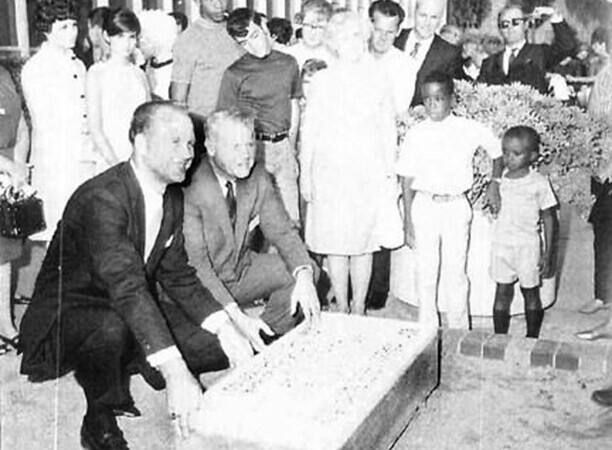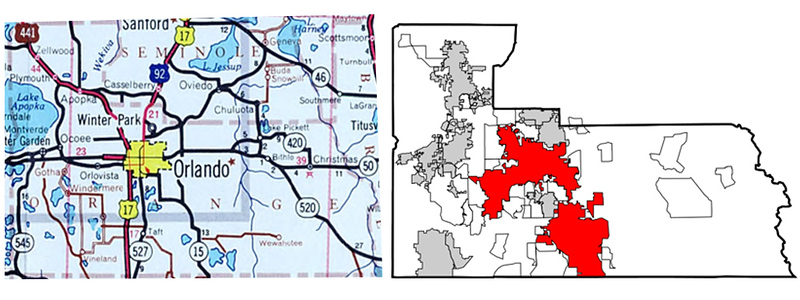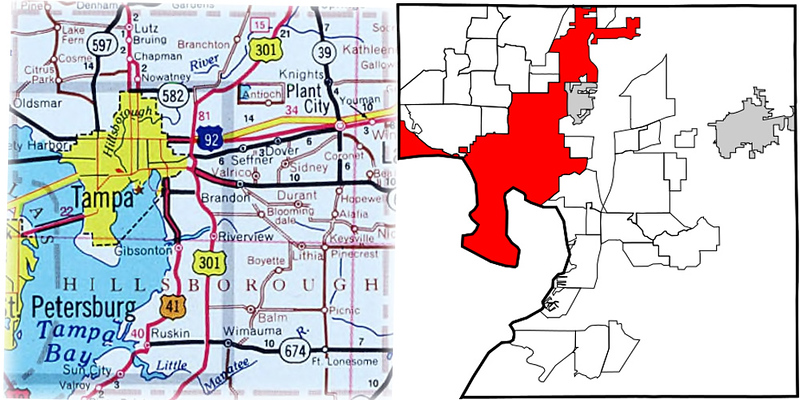
Jacksonville City Hall provides no shortage of things to criticize, but there are some common complaints that don’t stand up to scrutiny. Looking around the country shows that.
Myth 1: Jacksonville City Council is too big
Reality: Jacksonville City Council is smaller than the councils of other consolidated cities
One recurring claim about Jacksonville’s city government is that its 19-member City Council is too big to function coherently. The idea is that the body, comprising 14 district Council members and five at-large members elected by the entire city, is too inefficient and unwieldy to make decisions. The claim has been made by some Council members themselves; in 1997, then-Councilman Jim Overton floated the idea of reducing the size of the Council, and in 2020, Councilman Garrett Dennis introduced legislation that would shrink the Council by removing the five at-large seats (more on at-large seats in a moment). Members of the media have echoed these sentiments, and it’s a common refrain from citizens during public comment sessions.
It certainly sounds reasonable. Trying to make a decision in a diverse group of 19 is many people’s idea of hell. However, the myth doesn’t stand up to a review of other cities. Cities with large populations frequently (though not universally) have larger councils to ensure more people and neighborhoods have representation. For example, Chicago has 50 aldermen and New York City Council has 51 members. Thanks to the consolidation of the city and county governments, Jacksonville had a population of 995,567 as of 2020, making it the 12th largest city in the U.S.
It’s unsurprising it would have a large City Council. The best direct comparison for Jacksonville is with other consolidated cities with similar populations. Looking at Jacksonville’s consolidated peers, its Council is actually on the small side.
Jacksonville
- Population: 995,567
- Council members: 19 (14 district; 5 at-large)
- Population per district Council members: 71,112
- Population per all Council members: 52,398
Indianapolis
- Population: 887,642
- City-county Council members: 25
- Population per district Council members: 35,506
- Population per all Council members: 35,506
Nashville
- Population: 689,447
- Metropolitan Council members: 40 (35 district; 5 at-large)
- Population per district Council members: 19,698
- Population per all Council members: 17,236
Louisville
- Population: 633,045
- Metro Council members: 26
- Population per district Council members: 24,347
- Population per all Council members: 24,347
Of course, there are cities with smaller legislative bodies than these, including consolidated cities; the city and county of Denver has only 13 council members for 715,522 people. But the point remains: Nashville, Louisville and Indianapolis have larger councils than Jacksonville and aren’t worse off for it. Whatever Jacksonville’s problems, the size of its City Council is not to blame.
Myth 2: At-large Council seats harm representation
Reality: A mix of district and at-large seats is a good way to balance neighborhood needs and citywide needs

At-large Council seats are also frequently criticized, not only for adding to the supposedly excessive size of the Council, but because they dilute the voting power of minorities. This myth is based on reality: In the past, especially, at-large voting absolutely reduced representation for minorities, particularly in cases where multiple winners would be chosen from the same vote. By its nature, at-large voting tends to favor candidates who appeal to the majority, meaning that those in the minority have a much harder road to elect candidates representing their interests and neighborhoods. In the Jim Crow South and many other parts of the country, at-large voting served to repress minority say in their government
At-large voting was common in all levels of government before the Civil Rights Act of 1965, with a number of states (including Florida) even choosing some or all congressional representatives in this manner. Since the passage of the Civil Rights Act, many local and state governments have shifted toward district voting or a hybrid system with both district and at-large seats. Jacksonville’s current Council is one such hybrid system.
Research since the 1980s shows that mixed Council schemes like Jacksonville’s largely avoid the problems of purely at-large voting of years past. In fact, mixed systems typically provide the same benefits to diversity and representation as district-only systems. At-large seats do have notable benefits — in particular, they tend to result in candidates with citywide appeal, providing a balance between district interests and citywide vision. This is evident in Jacksonville, where a number of our best, most forward-thinking Council members have served at-large. And moreover, a number of Jacksonville’s peers, including consolidated Nashville, have hybrid systems.
Myth 3: Consolidation is the source of Jacksonville’s problems
Reality: Consolidation was a response to Jacksonville’s problems, and it’s been largely effective

Criticism of Jacksonville’s consolidation goes all the way back to when it was originally proposed. One claim, especially common among pontificators on Twitter, is that consolidation was an outright failure and the source of many of the city’s most intractable problems, in particular the decline of Downtown and the urban core neighborhoods around it. The problem with claims like these is that they tend to view Jacksonville as a city in a bubble, subject to unique problems that don’t exist anywhere else. But if consolidation were really at the heart of Jacksonville’s urban struggles, you’d expect that other cities would have developed much more effective solutions. Spoiler: They didn’t.
Consolidation wasn’t the cause of Jacksonville’s problems, it was a response to demographic trends that affected most cities across the country, such as mass suburbanization, white flight and the consequent collapse in tax revenues. All cities had to contend with these forces, and they developed a variety of ways to deal.


In Florida, many cities made up for their spiraling tax base by simply annexing vast tracts of suburban land. Orlando added 80 square miles of land, while Tampa added 94. Maps of these cities show the downsides of this approach: While consolidation added all neighborhoods, rich and poor alike, the Central Florida approach grabbed new high-growth areas while strategically leaving out neighborhoods that are distressed. In Orange County, some unincorporated areas are partly or entirely surrounded by the city of Orlando.
This is certainly not a fairer, more equitable way of addressing problems than consolidation. As a solution to national problems of the mid-20th century, consolidation holds up remarkably well.
Myth 4: Consolidation continues to hold Downtown and the urban core back
Reality: If true, other consolidated cities would have the same problem – and they mostly don’t
Related to Myth 3 is the argument that Jacksonville’s consolidated government continues to hold back its Downtown and many of the surrounding neighborhoods. It’s certainly true that Downtown struggles, and the urban core neighborhoods, while finally growing again, lost 100,000 people – 50% of their population – between 1950 and 2010. But what effect did consolidation have on this?
If consolidation really did cause generations-long decay, you’d expect to see the same effect in other consolidated cities. Again, a look beyond the Duval County line shows that most other consolidated cities don’t have especially distressed Downtowns. In fact, some are quite vibrant, like in Nashville, Louisville and Indianapolis, as well as larger consolidated cities like Philadelphia, Denver, San Francisco and New York, which is consolidated with five counties. There are also plenty of vibrant urban neighborhoods in Jacksonville, including Riverside, San Marco, Murray Hill and Springfield. And of course, some non-consolidated cities struggle with their Downtown and urban neighborhoods as much as or more than Jacksonville.
It’s easy to see why this myth has caught on: It provides a simple explanation for a complex problem. But Jacksonville’s urban problems predated consolidation, and in fact consolidation provides tools for leaders to channel the resources of the entire county into solving problems, including the struggles of our urban neighborhoods. And as we’ve argued before, many of those problems aren’t nearly as difficult to solve as is often assumed.
For Jaxsons interested in improving Jacksonville’s most serious problems, the answer may be even simpler. Most of our city’s issues could improve dramatically with a little vision and follow-through from our leaders.







